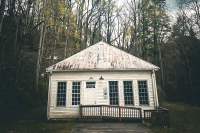Adaptation helps plants weather the cold
As I write this on Tuesday morning there are five or so inches of snow covering the ground outside my window. The forecast on the Internet is for more snow. By Thursday there may be upwards of 10 inches.
My wife and I protect ourselves from the elements by having an artificial structure (our house) to live in. We can put on additional clothing. We keep the woodstove in the living area stoked up. Bedroom, bathroom, and office doors can be closed so as to maintain warmth in the living area. Soup is simmering in a crock pot. This is our version of hunkering down.
Plants, however, can’t generate warmth by movement or contrived means at any time. Instead, they have devised a series of ingenious devices that allow them to survive in freezing snowbound conditions.
All plants in upland or northern environments face the double-edged dilemma of low temperature stress and lack of moisture in winter. Most opt to hunker down in cold weather in various forms. Herbaceous perennials die back completely and overwinter as dormant corms or regenerative root stock; and broadleaved deciduous trees, shrubs, and various vines shed their leaves and take other protective measures.
Evergreens have taken the other fork in the evolutionary path. They tough winter out with their foliage intact so as to obtain a head start when the growing season arrives. For this group of plants, photosynthesis can continue longer in the fall and begin earlier in spring; indeed, keeping their leaves actually helps them to survive since they can use them in photosynthesis on mild winter days. Come spring, energy that would otherwise be channeled into producing leaves is saved for direct reproductive efforts.
Various strategies allow evergreens to weather the drying winds and freezing temperatures of winter. Conifers have needlelike leaves that expose less surface to cold, drying winds than broader leaves. Their needles, stems, and roots are filled with “botanical antifreeze” in the form of resinous chemicals. Conical shapes minimize buildups of snow or ice.
Related Items
Other evergreen plants have developed thick leaves with waxy coats to cut down on evaporation. They tend to be shrubby or ground hugging. In order to avoid having their leaf cells ruptured by frost, water is channeled to spaces between the cells where expansion does less damage. And finally, the sugar content of the cells is increased to lower their freezing point.
Individual evergreen species often have their own distinctive overwintering devices. Everyone has observed how rhododendron leaves curl and droop in extreme cold. Drooping (a dormant posture also assumed during periods of drought) lessens exposure to wind, while curling temporarily shields and closes off air-circulation pores (stomata) on the underside of the leaves.
A little book by Peter J. Marchand titled Life in the Cold: An Introduction to Winter Ecology (1987) provides a lot of interesting information on this topic. I was particularly struck by the tables he presents that provide the freezing or “killing” levels for various tree species.
He makes the point that most species have adapted to the cold by adjusting their freezing tolerance so that it closely matches the minimum temperature at their northern range limit. For instance, live oak, a southern tree of the Gulf Coast and lower Atlantic coastal plain, will tolerate temperatures down to 15 or so degrees Fahrenheit. Eastern redbud, a tree of our low elevation forests here in WNC that ranges northward to the Great Lakes, dies when subjected to temperatures approaching minus 31 degrees.
Other deciduous trees that range into the higher elevations in WNC like northern red oak, shagbark hickory, American beech, and yellow birch withstand temperatures in the minus 35-49 degree range. Red spruce and Fraser fir, trees that grow in our highest elevations above 6,000 feet, can easily make it in temperatures below minus 112 degrees, an unlikely occurrence.
Some tree species have adapted especially for the regions in which they find themselves. For instance, sycamores in Mississippi will die in the event of minus 4 degree temperatures, while sycamores in Minnesota can tolerate temperatures down to minus 40 degrees. Eastern white pine shows a similar range adaptability.
The message in all of this for us humans is to prepare for the harshest weather situation we might encounter and then hunker down. Or we can always migrate to Florida.
George Ellison wrote the biographical introductions for the reissues of two Appalachian classics: Horace Kephart’s Our Southern Highlanders and James Mooney’s History, Myths, and Sacred Formulas of the Cherokees.









